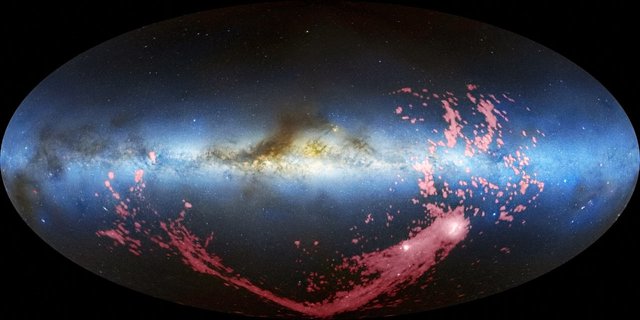Gaia satellite generates the most detailed map of the Milky Way ever

The European Space Agency (ESA) has just revealed an incredible map of the galaxy, with nearly 1.7 billion stars. Generated thanks to measurements made by the Gaia satellite, it offers a unique look, in color and in three dimensions, on the Milky Way. Beyond this magnificent spectacle, this unprecedented database promises major scientific breakthroughs that could trace back to the origins of our galaxy.
The dream of traveling to the confines of our galaxy is undoubtedly still utopian. Anyway, the world now has an incredible atlas of the Milky Way, on which appear, in three dimensions, and in color, no less than 1.7 billion stars. What to sail - at least virtually - in the depths of the cosmos. Revealed yesterday as part of the I LA Berlin Air Show, this extraordinary map of the galaxy is the result of several years of measurements by Gaia, a satellite launched in 2013 by the European Space Agency (ESA). Since it went into orbit a little more than 1.6 million kilometers above our heads, the machine has continuously collected information on the stars that make up the Milky Way. Result, in 2016 already, the satellite offered us a first version of the map of our galaxy . On this atlas was the position and luminosity of a little more than a billion stars, but only the distance and the trajectory of 2 million stars had been measured.
A map with incredible richness
The map offered today by Gaia goes well beyond what scientists had until now. It is in fact now the positions, distances, trajectories, luminosities and colors of more than 1.3 billion stars are listed. One hundred million of these celestial bodies also revealed their surface temperature. This unpublished database has enabled scientists to generate the three-dimensional map that has just been unveiled. It is the result of the collaboration of a consortium of 450 researchers and computer engineers who are engaged in the analysis and validation of data recorded by Gaia. And the least we can say is that the mass of work was colossal. Every minute, nearly 100,000 stars are analyzed by the satellite's sensors, which can cover the entire sky in about two months and also observe other objects such as asteroids. " Over five years of Gaia's lifetime, we will actually get 29 measurements independent of the whole sky , " ESA Scientific Director Günther Hasinger told the ILA Berlin Air Show.
An unprecedented promise for astronomical research
This unprecedented collection of data promises scientific breakthroughs until then unexpected. The measurements made by Gaia not only make it possible to establish a detailed map of the Milky Way, but also to go back to the origins of our galaxy. The properties of stars are indeed exploited by researchers to reconstruct the evolution and structure of the Milky Way. Work already largely started by scientists. Gaia project specialists have already presented preliminary results from the mission. Astronomer Anthony Brown of the University of Leiden, the Netherlands, and his team revealed a map of the clouds of gas and dust floating in our galaxy, as well as that of movements of more than 7 million stars around us. An image facing which Anthony Brown lets out a " Wow!" . " Basically, you see the entire Milky Way moving around its axis in this single image," says the scientist. The enthusiasm that the three-dimensional map of the galaxy also gives him. " The first time I saw her, I was at home, I turned off all the lights and I just sat there, in the dark, for a moment, staring at this picture because she's really so beautiful, " says Anthony Brown. The specialist advises everyone to do the same by downloading the card to " admire it in the dark . " A tantalizing virtual epic to the far reaches of the Milky Way, which will no doubt satisfy the most impatient, before interstellar voyages become a reality. The Gaia satellite will continue its mission. His latest data are expected for the 2020s.
Congratulations @verma! You have received a personal award!
Click on the badge to view your Board of Honor.
Do not miss the last post from @steemitboard:
Congratulations @verma! You received a personal award!
You can view your badges on your Steem Board and compare to others on the Steem Ranking
Do not miss the last post from @steemitboard:
Vote for @Steemitboard as a witness to get one more award and increased upvotes!